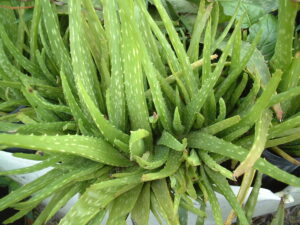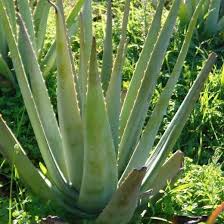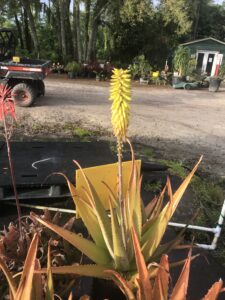S & J Nursery’s Guide to Growing
Aloe Vera / Aloe Barbadensis
in the Northeast Florida Jacksonvilel | St. Augustine area Landscape
( Aloe vera / formerly known as Aloe vulgaris and more
recently Aloe barbadensis Miller and Aloe vera var. chinensis )
Aleo Vera / Aloe barbadensis Origins and Intro. :
Although most of the several hundred species of Aloe are thought to originate in South Africa, the origins of the Aloe vera plant so
far as I can tell remain unknown. Perhaps no other plant that I have researched or grown has been shrouded in more confusion than the Aloe Vera. It seems to be rooted in the fact that no natural or wild populations are left. In addition the cultivation of Aloe vera has dated back for millenia
with naturalized populations frequently found along known trade routes. Where there is millenia of cultivation, there are selective differences bound to occur through time.
There also seems to be some debate as to whether all plants currently being
sold as Aloe Vera are the same or if they are actually two seperate species, some sources indicate a difference in the Aloe with more heavily spotted leaves and orange flowers (see photo on the right) and list them botanically as Aloe vera var. chinensis ( thought to be a hybrid of Aloe Vera with Aloe officionalis) while others simply say that Aloe vera may have yellow orange flowers (
Aloe officionalis) while others simply say that Aloe vera may have yellow orange flowers (
not actually an uncommon thing in listings of Aloe plants as many of them easily cross with other similar aloe species plants and in truth both the yellow and the orange
blooming Aloe vera vary widely in spots and leaf color at all ages ) AND IF THAT WAS NOT ENOUGH FUN FOR YOU…. Theres always the fact that the botanical name has changed from Aloe vera to Aloe barbadensis and then back to Aloe vera again! Thats just fun for everyone! So depending on when the books on Aloe were written, you will find it botanically classified as one of the two.
The Aloe considered by some botanically to be the original Aloe vera and commonly referred to now as Aloe barbadensis Miller (pictured left below), although what made them decide this is still unclear, starts out a bright green with white spots and as the plant reaches about a foot high turns a darker more almost olive like green and begins to loose some of it’s spots. Aloe Vera ( arbadensis ) will also have yellow blooms, a tell tale sign of which one you have! Both types of Aloe vera make great easy care garden plants!
 Sun Exposure of Aloe vera ( Aloe barbadensis ):
Sun Exposure of Aloe vera ( Aloe barbadensis ):
– Plant Aloe in a full sun to a partially shaded location in the Northeast
Florida | Jacksonville | St. Augustine area landscape.
Foliage / Growth Habit and Height of the Aloe vera plant:
– Aloe vera grows into a clump of foliage if the pups are not dug out
and planted in other areas of the garden at least once a year. The younger foliage is a brighter green with many white spots decorating the leaves and as it matures the foliage looses many of its spots and turns a deeper
olive green color.
– Aloe vera plants will grow 2 feet high and wide and bloom stalks can be 3-5 ft high.
– Foliage can cold damage at 25-30 degrees and plants will recover
quickly in summer from any frost damage or discoloration that occurs during our Northeast Florida Jacksonville and St. Augustine landscapes. For me in my St. Johns county home garden only a slight discoloration occurs even in the worst of winters and they seem to green back up with no extra fertilizer or trimming etc. in the spring.
Soil Preference / Salt tolerance of Aloe vera ( Aloe barbadensis):
– Drought tolerant once established into the landscape, Aloe vera plants
make great xeroscape plantings and can be planted straight into Florida’s sandy soil without worry of amending the soil for it to hold water or nutrients.
– Avoid planting Aloe into areas of the landscape that hold water after our
frequent rains. If you don’t have the best drainage, consider planting your Aloe into a raised berm where the roots will be up out of the wet zone during the rainier times of the year. You can also use them as a container
planting and keep them in a decorative pot in the garden.
– Aloe plants are a great choice for the coastal areas of
our Northeast Florida landscape.
Blooms of the Aloe vera plant:
– Butterfly and hummingbird attracting, spring and sumer flower spikes
rise high above the foliage reaching 3-5 ft tall and are a beautiful bright yellow color.
Water Requirements of Aloe Plants:
– Although much more durable once established in the landscape, regular water is necessary to get the plant rooted and growing on its own after being planted in the ground from an S & J Tree Farm and Nursery container. Water once to twice a week for the first few weeks after planting.
 Care of Aloe vera in the Northeast Florida / Jacksonville and St. Augustine area garden:
Care of Aloe vera in the Northeast Florida / Jacksonville and St. Augustine area garden:
– Low care landscape pant selection.
– Water once to twice a week during the establishment period after planting in the garden from an S & J Tree Farm and Nursery container. After the establishment period the Aloe plant can be left to grow on its own in the ground or in a decorative container.
– Aloe plants will prefer areas with excellent drainage, avoid water logged
soils or areas that drain slowly after a rain.
– Fertilize each spring with a shovel full of good garden compost or a slow
release poly coated plant food such as Osmocote or Stay Green general
purpose plant food or 10-10-10.

